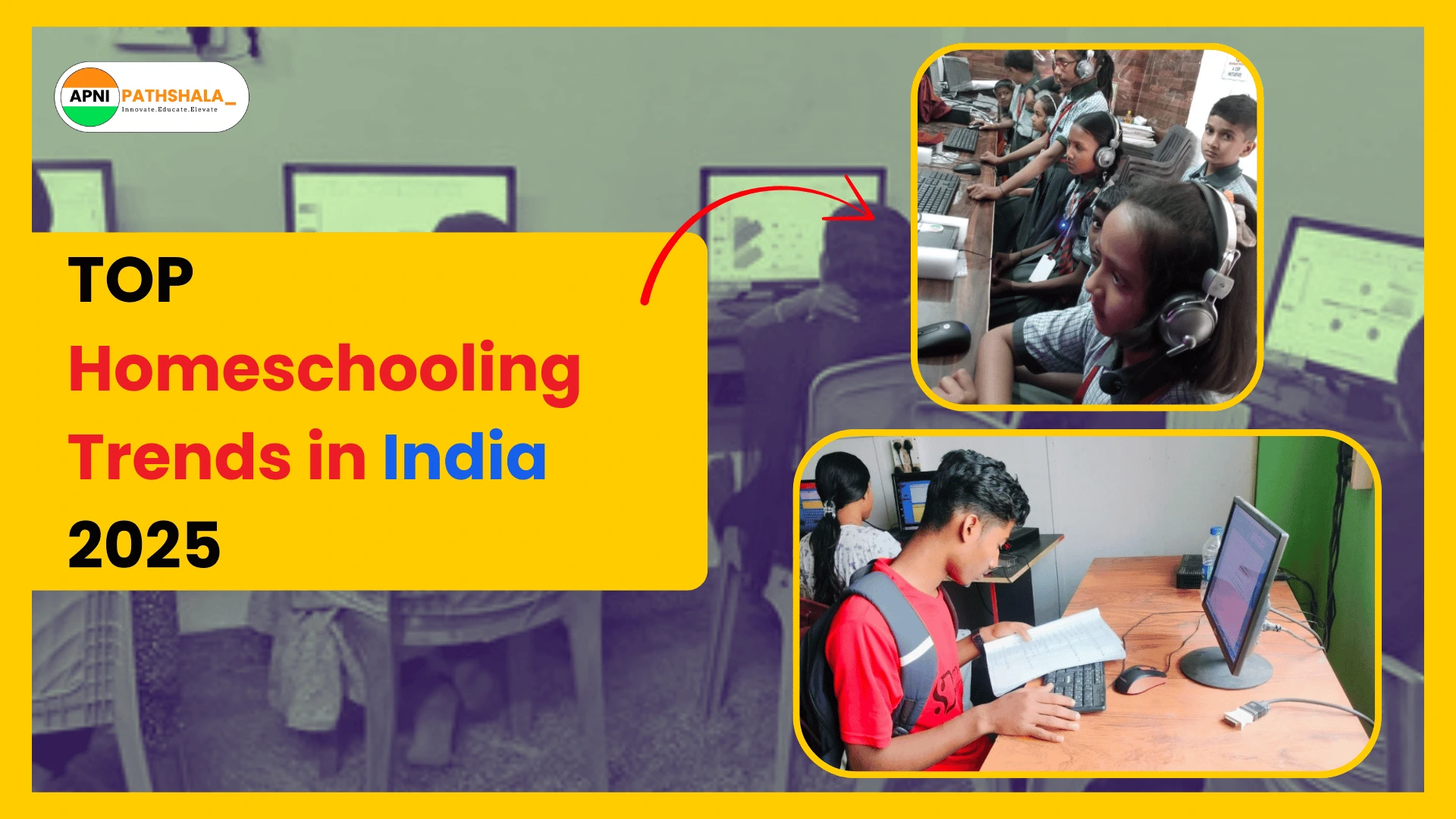A quick question for you. When you hear the word “homeschooling,” do you still picture kids sitting at the dining table with a pile of books while parents try to be teachers?
Well, things have changed. A lot.
In 2025, homeschooling is not just about staying at home. It’s about using smart tools like AI, and learning in a way that actually suits your child and not the other way around.
Kids are learning at their own speed, choosing topics they enjoy, and getting help from technology that understands what they need. It’s like having a personal classroom that’s built just for them.
If you’re a parent thinking about homeschooling, already doing it, or just curious about what’s new, this blog is for you.
Let’s look at what’s trending in homeschooling right now, and how you can make the most of it for your child.
1. Artificial Intelligence in Homeschooling
You’ve probably heard the word “AI” so many times, it feels like the most overhyped word. But when it comes to homeschooling, AI is not hype, it’s help.
And it’s changing how Indian children learn at home.
How is AI being used in homeschooling?
- Learning apps have started using AI to adapt questions to your child’s level.
- Your child gets instant feedback when they get stuck (no waiting for a tutor).
- AI recommends what to study next based on what your child understands well vs. where they struggle.
Instead of giving your child the same worksheet as every other kid, AI lets them learn at their own pace, in their own way.
It’s not about replacing parents or teachers. It’s about supporting them, so the learning feels personal and progress is clear.
Why do parents love this?
- You don’t need to be an expert in every subject (because AI is).
- Your child is more engaged because they’re not bored or overwhelmed.
- It saves time and effort while still giving you control.
2. Mobile-First Learning
Here’s the truth: Not every homeschooling family in India can afford laptops, fancy setups, or high-speed Wi-Fi. But, this does not have to be a roadblock in a child’s education. This is because from rural India to the urban one, almost everyone has a smartphone. Plus, there are a lot of government initiatives where smartphones are regularly distributed to the needy ones.
And in 2025, that’s enough.
How can you use it?
- Hail Youtube! Using free educational YouTube channels in Hindi, Tamil, Bengali, and more.
- Sharing PDFs and audio notes through WhatsApp homeschooling groups.
- Using sites like BeyondExams and apps like Khan Academy that are designed for low-data, mobile-first learning.
Whether you’re in Delhi or a small town anywhere else, your child can now access quality content using just a smartphone.
And parents are loving this shift because it’s:
- Cost-effective (many tools are free or low-cost)
- Accessible from anywhere
- Flexible (learn at any time of the day)
Mobile-first learning is a big reason why homeschooling is becoming more practical across India, not just for the elite.
3. Personalized Learning Plans
This isn’t about using high-end tech. This is about changing how we think about learning.
Today, more Indian parents are ditching “fixed” timetables and standard textbooks in favor of personalised learning, because every child learns differently.
What does this look like?
- Mixing course books with skill-based learning (coding, art, music, etc.)
- Building weekly or monthly plans that focus on your child’s interests
- Choosing your own mix of textbooks, online tools, and real-world activities
Let’s say your child is strong in math but struggles with writing. You don’t need to spend equal time on both. Focus more on writing, and let them move faster in math. That’s the beauty of personalised learning, it’s efficient and child-focused.
How are parents doing it?
- Using Google Sheets or Notion to plan their child’s week
- Taking help from platforms like BeyondExams to track progress
- Regularly discussing with their child what’s working and what’s not
In short, you become the architect of your child’s education. And it works. Want a testimonial?
4. Hybrid Homeschooling
Full-time homeschooling is a big step. Some parents want flexibility, but also the structure of school. That’s where hybrid homeschooling is becoming popular in Indian cities.
What is Hybrid Homeschooling?
Hybrid homeschooling is a flexible approach that blends the structure of traditional schooling with the freedom of homeschooling. Instead of choosing between full-time school or full-time homeschool, you can do both on your own terms.
Here’s how hybrid homeschooling works in 2025:
- Going to school a few days a week (usually 2–3 days): Children attend a regular school part-time—enough to stay connected with classmates, follow some standard curriculum, and experience a classroom setting.
- Homeschooling at home on the other days: Parents (or tutors) take charge of the child’s learning on non-school days. You can teach core subjects, work on passion projects, or even explore alternative methods like project-based learning or unschooling.
- Learning pods, online classes, and fieldwork: Kids might join small group classes (learning pods) with other homeschoolers, take online courses in subjects like coding or art, or go for nature walks, science experiments, or museum visits as part of learning.
Why are Indian families loving hybrid homeschooling?
- Children still get social interaction: They build friendships, learn teamwork, and stay emotionally connected, all without being stuck in school five or six days a week.
- Parents stay in control: You can decide what your child learns at home: values, languages, cultural lessons, hobbies, or even financial literacy. It’s a mix of structure and freedom.
- Less stress, more balance: Many children find long school hours draining. Hybrid homeschooling reduces screen fatigue and burnout. Kids have more time for rest, creativity, and family time.
- Custom schedules for modern families: Hybrid homeschooling also works well for families with flexible jobs, travel lifestyles, or kids pursuing extracurricular goals like sports, music, or entrepreneurship.
Many schools are even open to flexible attendance now, especially after COVID.
Parents all over are creating hybrid learning schedules that balance academics, hobbies, and emotional health. And the results? Children are more relaxed, more focused, and more curious. Read this story of Lakshya, a seven year old who builds robots and is getting homeschooled by his father.
5. Community-Based Microschools
This is one of the most heartwarming homeschooling trends in 2025.
Instead of sending kids to a big school, families in the same apartment, neighbourhood, or society are starting microschools. Think of it as a mini school run by parents and local facilitators.
What does a microschool look like?
Imagine 5 to 15 kids of different age groups, learning together like in a big joint family. There are no rigid time tables or heavy textbooks. Learning happens through hands-on activities, meaningful discussions, curiosity-led projects, and real-life experiences.
Often, these kids are taught not by certified teachers, but by parents, freelancers, retired educators, or even college students who are passionate about a subject. Some bring in local artists or science communicators. Others take kids on field visits to farms, libraries, or even nearby construction sites to understand how the real world works.
Why is this trend catching on in 2025?
- Children feel emotionally safe and connected: Unlike big schools, microschools are intimate. Every child is known by name. They feel seen, heard, and respected.
- Parents share the load and the cost: Instead of hiring private tutors for everything, parents take turns teaching or pooling in for a local educator. It builds trust and teamwork.
- Learning becomes real and rooted in life: Kids learn maths by budgeting groceries, storytelling by writing local folktales, and science by planting kitchen gardens. This is personalized learning in the truest sense.
- There’s space for creativity and flexibility: No pressure of standardized exams, no fear of “falling behind.” Children can go deep into topics they care about, whether that’s astronomy, drawing, or how machines work.
If you’re exploring homeschooling in 2025, just know, you’re not the only one figuring it out.
From AI tools to small learning pods, families across India are rewriting the rules. It’s not always easy. But it’s real. It’s personal. And it’s working.
At ApniPathshala, we’re walking this journey with you. We help learning pods get the basics like personal PCs and guidance, so kids can actually thrive, not just study.
If you’re starting something, or even thinking about it, we’d love to help.


2 Comments
Your comment is awaiting moderation.
The best is hybrid schooling it is best for students groups of their classmates
And also self learning
It’s inspiring to see how homeschooling in India is evolving with the help of AI, mobile learning, and community microschools. I especially loved the part about personalized learning plans — it really shows how education can be shaped around each child’s needs
This shows exactly what Apni Pathshala is all about — helping every child learn in a simple, smart, and flexible way! 🌟